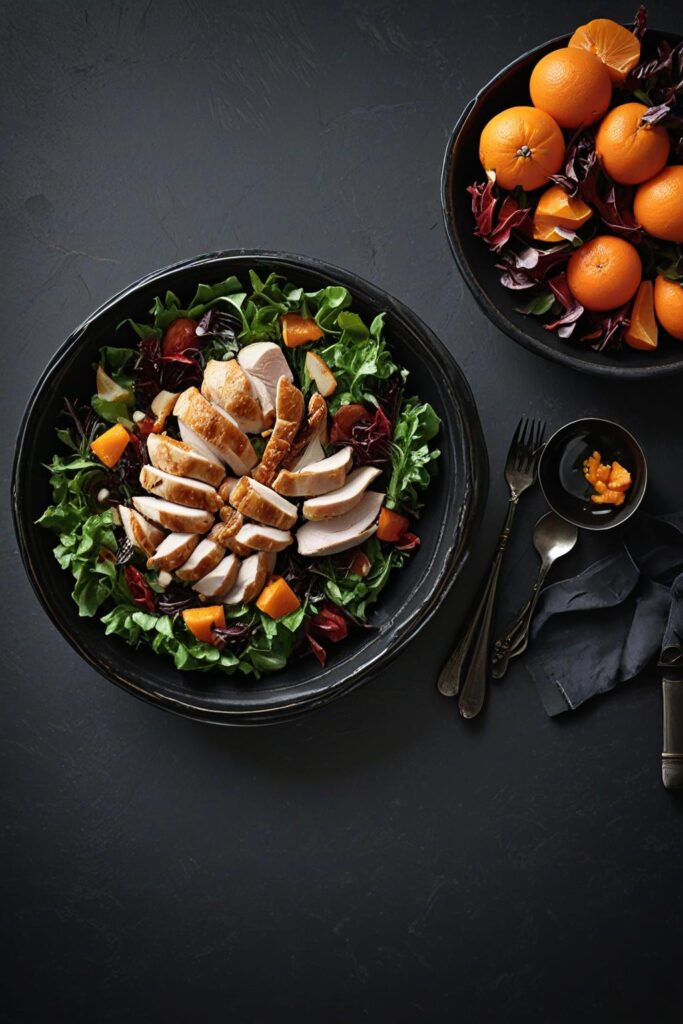Last summer, I found myself staring at a bowl of leftover grilled chicken and a package of dried cranberries, wondering what magic I could create. That desperate moment of culinary improvisation birthed what’s now become my most requested recipe at family gatherings. Asian Chicken Cranberry Salad sounds like an odd collision of east-meets-west, but trust me—the combination works brilliantly.
This ain’t your average chicken salad. The sweet-tart cranberries dance with umami-packed sesame and soy, while the crunch of fresh vegetables creates a textural symphony that keeps your fork coming back for more. What makes this salad special is its perfect balance—not too heavy, not too light, substantial enuff to serve as a main course yet refreshing enough for the hottest summer day.
Ingredients & Substitutions
For the Salad Base:
- 2 boneless, skinless chicken breasts (about 1 pound), cooked and shredded
- 3 cups Napa cabbage, thinly sliced
- 1 cup red cabbage, thinly sliced
- 1 large carrot, julienned or grated
- 1/2 cup dried cranberries
- 1/3 cup sliced almonds, toasted
- 3 green onions, thinly sliced
- 1/4 cup fresh cilantro, roughly chopped
- 1 cup crispy chow mein noodles
The chicken can be swapped for firm tofu or tempeh for a vegetarian option—just make sure to press the tofu thoroughly and pan-fry until crispy with a bit of soy sauce. Got a cranberry hater in the house? Dried cherries or even chopped dried apricots provide similar sweet-tart notes. The Napa cabbage brings a delicate texture that regular cabbage can’t match, but in a pinch, regular green cabbage will work—just slice it extra thin.
If tree nut allergies are a concern, substitute toasted sunflower seeds or pepitas. They’ll deliver the same satisfying crunch without the worry. For those avoiding gluten, rice noodles broken into small pieces and quickly fried make an excellent alternative to chow mein noodles.
For the Asian-Inspired Dressing:
- 3 tablespoons rice vinegar
- 2 tablespoons low-sodium soy sauce (or tamari for gluten-free)
- 1 tablespoon honey (or maple syrup for vegan option)
- 1 tablespoon sesame oil
- 2 tablespoons neutral oil like grapeseed or canola
- 1 garlic clove, finely minced
- 1 teaspoon fresh ginger, grated
- 1/2 teaspoon sriracha (optional, for heat)
Rice vinegar provides a mild acidity that complements rather than overpowers—white wine vinegar works in a pinch but lacks the subtle sweetness. Always opt for low-sodium soy sauce; regular soy sauce can quickly make your dressing too salty. The combination of neutral oil plus sesame oil creates the perfect balance—all sesame would be overwhelming, while no sesame would miss that characteristic Asian flavor profile.
Fresh ginger absolutely transforms this dressing. Pre-minced jarred ginger is convenient but lacks the bright, zesty quality of freshly grated root. Keep your ginger in the freezer and grate it frozen—it’s easier to handle and lasts practically forever.
Step-by-Step Instructions
Preparing the Chicken
- Begin with properly cooked chicken—either poach boneless, skinless breasts in simmering water for about 15 minutes until internal temperature reaches 165°F, or use a rotisserie chicken for convenience.
The secret to perfect poached chicken is to never let the water reach a rolling boil—this tuff-ens the meat and creates that chalky texture nobody wants. Consider adding aromatics like ginger slices, garlic cloves, and a splash of soy sauce to the poaching liquid to infuse flavor directly into the chicken.

After resting for 5-10 minutes (don’t skip this step!), shred the chicken using two forks or your fingers. Shredding while slightly warm allows the meat to absorb dressing better than cubed chicken. Avoid shredding too finely—you want distinct pieces that hold there own against the other ingredients.
Making the Dressing
- Combine all dressing ingredients in a jar with a tight-fitting lid and shake vigorously until emulsified.
A common mistake is adding the oils all at once. For the smoothest emulsion, whisk the vinegar, soy sauce, honey, and other ingredients first, then slowly drizzle in the oils while whisking constantly. This creates microscopic droplets of oil suspended in the acidic base, resulting in a silky, cohesive dressing that won’t separate.
Taste and adjust seasoning—this is crucial. If it’s too tangy, add a touch more honey. Too flat? A pinch of salt or extra soy sauce. Too strong? Dilute slightly with a teaspoon of water. The dressing should taste slightly more potent than you think necessary, as it will mellow when coating all those vegetables.
Assembling the Salad
- In a large bowl, combine both cabbages, carrots, green onions, and cilantro.
Proper cutting technique matters tremendously here. For the Napa cabbage, remove the core and slice crosswise into thin ribbons no thicker than ¼ inch. The red cabbage should be even thinner since it’s tougher. Carrots are best julienned rather than grated—the longer pieces integrate better with the cabbage strands.
When mixing, use your hands (clean, obviously) instead of utensils. This allows you to gently toss without bruising the delicate Napa cabbage. It also gives you a better feel for when everything is evenly distributed.
- Add the shredded chicken and dried cranberries, tossing gently to combine.
Resist the urge to add the dressing yet! Letting the chicken and cranberries mingle with the vegetables first ensures more even distribution. The dried cranberries will begin to slightly plump from the moisture in the vegetables, resulting in a better texture contrast.
- Pour about two-thirds of the dressing over the salad and toss thoroughly to coat.
Always start with less dressing than you think you need—you can always add more, but you cant un-dress a soggy salad. Use a combination of tongs and a large spoon to lift from the bottom, turning the ingredients over repeatedly until everything glistens with dressing.
- Just before serving, add the toasted almonds and crispy chow mein noodles, giving one final gentle toss.
The timing here is critical. Add these crunchy elements too early, and they’ll soften from the dressing. Add them literally at the last minute for maximum textural contrast. Reserve a small handful to sprinkle on top for visual appeal and guaranteed crunch in every serving.
Cooking Techniques & Science
The brilliance of this salad lies in its textural contrasts and flavor balance. The sweet-tart cranberries contain high levels of naturally occurring antioxidants called proanthocyanidins, which create that distinctive astringent mouthfeel that cuts through the richness of the dressing. These compounds interact with the umami elements from the soy sauce and sesame oil to create a flavor complexity greater than the sum of its parts.

Toasting the almonds is non-negotiable. Raw almonds contain enzyme inhibitors that mute their flavor, while toasting not only deactivates these compounds but also triggers Maillard reactions—the same chemical process that makes bread crusts and seared steaks so irresistible. Simply spread them on a dry skillet over medium heat and shake frequently for 3-5 minutes until fragrantly nutty and golden brown.
The cabbage varieties aren’t random choices. Napa cabbage contains more water and has a more delicate cell structure than regular cabbage, allowing it to better absorb dressing while still maintaining crispness. The red cabbage, besides its visual appeal, contains different phytonutrients and a sturdier texture that holds up longer—making this a great make-ahead option.
For the chicken, the poaching temperature matters significantly. Proteins begin to denature and toughen at different temperatures. Chicken breast is at its juiciest- when cooked to exactly 165°F (74°C). Above that, the proteins squeeze out moisture; below that, safety becomes a concern. An instant-read thermometer is invaluable here.
Serving & Pairing Suggestions

This salad shines brightest when served in a large, shallow bowl rather than a deep vessel—it allows guests to see all the colorful components and makes serving easier. A pair of tongs alongside wooden serving spoons gives people the best control when helping themselves.
For an elevated presentation, consider serving individual portions on butter lettuce cups. The tender lettuce adds another layer of texture and essentially serves as an edible plate. A small extra sprinkle of black sesame seeds creates visual pop against the colorful backdrop.
When I serve this for lunch gatherings, I pair it with a light miso soup starter and finish with mango sorbet for dessert. The umami-rich soup primes the palate for the complex flavors in the salad, while the clean, bright mango offers the perfect acidic endnote.
For wine pairings, a slightly off-dry Riesling or Gewürztraminer complements the sweet-tart-umami flavor profile beautifully. The subtle sweetness in these wines stands up to both the cranberries and the Asian dressing elements. If you prefer beer, a Belgian witbier with its coriander and orange notes plays well with the salad’s bright flavors.
Make-ahead tip: This salad can be partially prepped up to a day ahead—combine all vegetables except cilantro and store in the refrigerator. Keep the dressing, chicken, and crunchy elements separate until about 30 minutes before serving. This prevents sogginess while still allowing the flavors to meld.
A Cultural Hybrid With Purpose
This salad represents more than just a convenient use of ingredients—it embodies the modern approach to fusion cuisine that respects traditional flavor profiles while creating something entirely new. The cranberries, typically assosiated with American holiday traditions, find unexpected harmony with Asian ingredients like sesame and soy that have been paired together for millennia.

The balance of sweet, sour, bitter, salty, and umami follows principles found in many Asian culinary traditions, particularly Chinese and Japanese, where contrasting yet complementary flavors create depth. However, the format—a hearty chopped salad—is distinctly Western. This respectful borrowing from multiple traditions creates a dish that feels both familiar and novel.
Whether served as a light summer dinner, packed for a gourmet picnic lunch, or presented as part of a larger buffet spread, this Asian Chicken Cranberry Salad delivers satisfaction beyond what you might expect from a simple salad. The combinations of flavors, textures, and temperatures creates a dining experience that engages all the senses.
The recipe can be scaled up easily for crowds—I’ve made it for gatherings of fifty with exactly the same techniques, just larger equipment. Its striking appearance makes it a centerpiece dish despite its relatively simple preparation. And unlike many leafy salads that wilt within minutes of dressing, the sturdy cabbage base means this salad actually improves after 30 minutes as the flavors meld.
Conclusion
The Asian Chicken Cranberry Salad represents the best kind of cooking—innovative without being pretentious, nutritious without sacrificing flavor, and impressive without requiring cheffy skills. The magic happens in the balance of flavors and textures: sweet cranberries against savory chicken, crunchy vegetables against creamy dressing, bright herbs against nutty almonds.
Don’t be surprised if this becomes your new potluck signature dish. I’ve had friends request it by name for gatherings, and I’ve watched as initially skeptical eaters (“cranberries and soy sauce?”) become immediate converts after the first fork-full. The recipe is endlessly adaptable to seasonal availability and dietary needs without losing its essential character.
For those looking to expand their salad repertoire beyond the predictable Caesar or Greek standards, this Asian-inspired creation offers a gateway to a whole world of cross-cultural culinary experimentation. And isn’t that what modern cooking is all about—taking the best from various traditions and creating something uniquely delicious?
Frequently Asked Questions?
Can I make this salad ahead of time?
You can prep most components up to 24 hours ahead, but keep the dressing, crunchy elements (almonds and chow mein noodles), and herbs separate until shortly before serving. Combine cabbages, carrots, and pre-cooked chicken in a sealed container in the refrigerator. The dressed salad will hold its texture for about 2 hours before the cabbage begins to soften too much.
Is there a way to make this salad more substantial for a main course?
Absolutely! Add cooked and cooled soba noodles or brown rice to transform it into a heartier meal. Edamame beans are another excellent addition for extra protein and staying power. For a dinner party, I sometimes serve it with sesame-crusted seared tuna on top for an elegant main course.
My family doesn’t like cilantro. What can I substitute?
Thai basil makes an excellent alternative with its slight anise notes complementing the Asian flavors beautifully. Fresh mint also works well, particularly in summer. If all herbs are contentious, flat-leaf parsley provides freshness without divisive flavors. Use about half the amount called for when substituting more potent herbs like mint.
How spicy is this salad, and how can I adjust the heat level?
As written, the recipe has just a mild background warmth from the small amount of sriracha. For heat-lovers, increase the sriracha to 1-2 teaspoons or add thinly sliced fresh jalapeño to the vegetable mix. For a no-heat version that maintains complexity, substitute sweet chili sauce for the sriracha.
Can I use leftover rotisserie chicken instead of poaching chicken breasts?
Rotisserie chicken is not just acceptable but recommended for time-saving! The slightly richer flavor of dark meat adds depth to the salad. Just be aware that some rotisserie chickens are heavily seasoned, so you might want to reduce the salt in your dressing accordingly. Remove the skin and shred about 2-3 cups of meat from a standard supermarket rotisserie chicken.

Veronica is a passionate food enthusiast with over three years of experience in exploring and writing about diverse cuisines. Her expertise lies in reviewing restaurants, sharing creative recipes, and discovering the latest food trends. As the voice behind FoodieRecap.com, Anju brings fresh perspectives and culinary insights to her audience.
